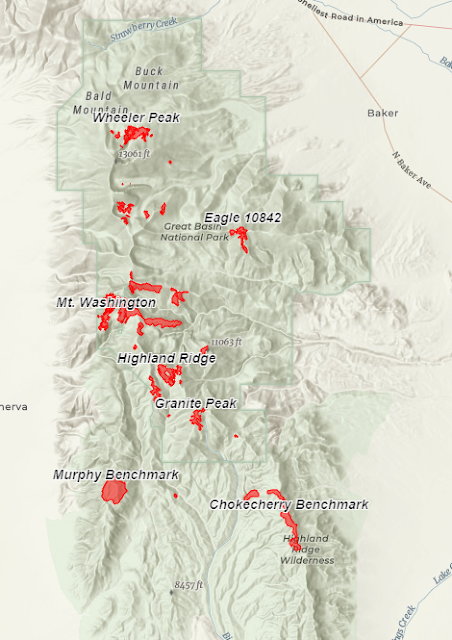Great Basin National Park features several ancient bristlecone pine groves. These trees are so important that there's even a replica of a bristlecone pine in the Great Basin Visitor Center in Baker, Nevada. (Can you spot the Clark's Nutcracker on it?)
So now we have to go a bit further to find the Great Basin bristlecone pine trees. They usually grow at elevations of about 9,000 to 11,000 feet. Within Great Basin National Park, the easiest grove to access is at the end of the Wheeler Peak Scenic Drive. Over the next few blog posts, I'll take you there and also to some groves that are harder to reach.
Until recently, a young bristlecone pine tree (transplanted in 1976 as part of a US bicentennial ceremony) could be found in the parking area near the Lehman Caves Visitor Center. Unfortunately, in 2022 it succumbed to damage from the Pinyon ips beetle, a native bark beetle that usually attacks pinyon pine trees.
Great Basin Bristlecone pines grow from the White Mountains in California, across many ranges in Nevada, and up to the edge of the Colorado Plateau in Utah. (A different species of bristlecone pine, the Rocky Mountain bristlecone pine (Pinus aristata) grows further east.)
This wonderful map shows the extent of Great Basin Bristlecone pine. Here's a link to the map, as it's interactive and you can zoom in and out: Great Basin Bristlecone Pine (Pinus longaeva D. K. Bailey) Distribution Map (arcgis.com)
Here's a close-up map of some of the places we'll be visiting.
You can find more about bristlecone pines here: Bristlecone Pine Distribution Mapping and Ecology (byu.edu)
And for a sneak peak of some of the areas we'll be going, check out: Bristlecone Pines - Great Basin National Park (U.S. National Park Service) (nps.gov).





No comments:
Post a Comment
Hi, I love to read your comments! I've recently decided to turn off word verification to make it easier to leave comments, but in doing so, I'm only accepting registered users to avoid spam. You can also leave comments on the Desert Survivor Facebook page. Thanks!